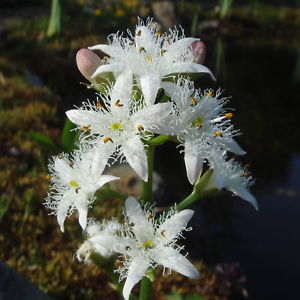At the end of July, an article by Professor Liu Huajie, who is from Peking University’s Department of Philosophy and Peking University’s Science Communication Center, titled “Save Beijing’s Buckbean!”, caught the attention of CBCGDF. Buckbean (Menyanthes trifoliata) is an aquatic plant that is distributed in Tiansongying, Yanqing County, Beijing. Perhaps it’s because it is too ordinary, no one knows how long it has grown in the canal of Tiansongying, and even the “Beijing Flora” has not yet to include this species. One day in April 2009, Professor Liu learned that Tiansongying in Yanqing had the species growing in bloom, he immediately drove there to check it out the next day. Since then, every year in April, Professor Liu Huajie will go to Tiansongying to visit the buckbean. However, a few years ago, due to the rectification of a small canal parallel to the Daqin Railway and the nearby road surface, the small canal was seriously damaged. Over time, some aquatic plants reappeared in the canal, but the buckbean disappeared…

(Photo source: Internet)
On the last day of July, CBCGDF’s staff decided to go on a field trip with Prof. Liu to the canal in Tiansongying of Yanqing County, where the buckbean had grown, to find this species! In the morning, they set off on the journey by driving. It’s the summer time and the sun was shining, the outdoor temperature was close to 45 °C. due to the road conditions, the car finally stopped after passing a small bridge after nearly two hours of driving. At first glance, where they arrived was not the canal that Prof. Liu mentioned, only with wild grass on one roadside, and plantation forest on the other side, and there were freight trains whizzing from time to time. Under the bridge, Prof. Liu pointed that there was a canal where once buckbean grew. Followed him, CBCGDF’s staff began to search for buckbean on foot.

(Photo: CBCGDF)
On one side of the bridge, they say a canal that was about one meter wide, with a shallow depth and was covered with a variety of aquatic plants. Prof. Liu told the guys that now the flat road under their feet was repaired with the soil from excavating in the canal. There are also some small ponds nearby, which can clearly see the artificial traces that have been excavated before. The guys went down to the canal several times, turned over in the grass, and found on trace of buckbean. Then they came to the other side of the bridge and continued to search for it. The canal there is more obvious, and they could see the river is running. They walked along the canal for a while. Many fast-growing poplar trees were planted on both sides of the canal. Prof. Liu said that the biodiversity there is actually not rich. Along the way, they also saw the “Public Information Signboard” standing next to the canal. It introduces the general situation of the river. While searching, they also learned some knowledge about the plants that Prof. Liu introduced, including reeds, wild water bamboo, Jerusalem artichokes, humulus japonicus (alien species), Melilotus suaveolens (very important native species) and so on.

(Photo: CBCGDF)
According to Prof. Liu, the freight trains that traveled through the Daqin Railway were not far away. To the north of the railway is Song Mountain, where the 2022 Winter Olympic Games’ Alpine Skiing Competition will be held. In 2009, the buckbean there was very strong. There was no road is like nowadays under their feet, and the buckbean grew in the canal that is right in front of them. The canal is relatively long and is almost parallel to the Daqin Railway. Later, because of the road repair and remediation, the soil in the canal was excavated, which caused the ecological environment of the canal to be destroyed. The plants with shallow roots were later restored, but the roots and stems of the buckbean were thick, the roots were developed, and the damage was severe. It has never appeared since then. At present, in the Beijing area, only the Tiansongying of Yanqing County is known for the growth of buckbean. Whether of not the growth of buckbean in other places has not been confirmed. Currently, the environmental basis of the canal is still relatively clear, the water is also active, there is no pollution, and the water quality conditions are still good. Prof. Liu hopes that the relevant departments can protect this area. If the buckbean species is reintroduced, planting in this place is supposed to grow well. People in Beijing can also revisit this beautiful native plant and see its flowers blooming in the spring.

(Photo source: Internet)
The value of buckbean is not only this, but the plant also has a high adsorption capacity to metal contaminants and also be used as a plant to repair contaminated wetlands. As a native plant, buckbean is an indispensable part of Beijing’s biodiversity, and it helps to beautify the city when it blooms. If it disappears, it is really regrettable!

(Photo source: Internet)
